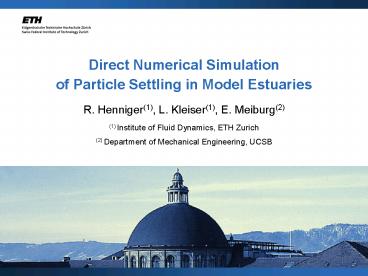Direct Numerical Simulation of Particle Settling in Model Estuaries PowerPoint PPT Presentation
1 / 28
Title: Direct Numerical Simulation of Particle Settling in Model Estuaries
1
Direct Numerical Simulationof Particle Settling
in Model Estuaries
- R. Henniger(1), L. Kleiser(1), E. Meiburg(2)
- (1) Institute of Fluid Dynamics, ETH Zurich
- (2) Department of Mechanical Engineering, UCSB
TexPoint fonts used in EMF. Read the TexPoint
manual before you delete this box. AAAAAAAAAAA
2
Outline
- Introduction / motivation
- Computational setup
- flow configuration
- governing equations and physical parameters
- simulation code
- Results
- freshwater / saltwater mixing
- particle settling
- Conclusions and outlook
3
Introduction
- Estuary mouth
- light fresh-water
- heavy salt-water
- Suspended particles
- e.g. sediment or pollutants
- transport out to the ocean
- particles settle and deposit
- Other influences
- temperature profile
- Coriolis effect, tide,
- Focus of the present study basic investigation
of - freshwater / saltwater mixing
- particle transport, particle settling and
particle deposition
Magdalena River (Colombia)
4
Freshwater / saltwater mixing
- Typically hypopycnal inflow
- (Super-)critical?
- Convective mixing, enhanced by
- turbulence in river
- Kelvin-Helmholtz or Holmboe waves
salty
salt wedge
freshwater
salty
5
Particle load
- hypopycnal
- hyperpycnal
freshwater particles
salty
freshwater particles
salty
6
Particle transport
- Surface plume
- (Enhanced) particle settling
- flocculation?
- turbulence enhanced settling?
- Bottom propagating turbidity
- current
(1)
(2)
(3)
7
Example Yellow River
(from http//www.grid.unep.ch/activities/global_ch
ange/atlas/images/YellowRiver.jpg)
8
Motivation
- Particle transport mechanisms
- surface freshwater current
- particle settling
- undersea gravity currents
- Consequences
- spillage of ocean bed /
- continental shelf
- environmental pollution
- disruption of infrastructure
- State of research
- many quantitative field observations
- few laboratory experiments
- little evidence about mechanisms
- Focus of the present study basic investigation
of - freshwater / saltwater mixing
- particle transport, particle settling and
particle deposition
9
Model estuary configuration
salt sponge
convective outflow
inflow
symmetry planes
10
Governing equations, non-dimensional
- Incompressible Navier-Stokes and concentration
transport equations (in Boussinesq regime) - Reynolds number
- Schmidt number
- Richardson number
- Particle settling velocity
11
Physical parameters
reality laboratory simulation
Re 105-107 103-104 1500
Scsal 500-3000 500-3000 1
Scpart gt Scsal gt Scsal 2
Risal 0.5-1 0.5-1 0.5
Ripart lt 0.05 lt 0.05 0.05
-us/U lt 10-2 lt 10-2 0.01-0.02
12
Newly developed simulation code (summary)
- Incompressible flows active scalars
- Discretization
- compact finite differences in space
- explicit or semi-implicit time integration
- Massively parallel platform
- 3D domain decomposition (gt95 parallel
efficiency) - sustained 16 peak performance on Cray XT
- scalability tested to up to 8000 cores and 17
billion grid points - Validation
- convergence orders in time and space
- convergence properties of iterative solvers
- temporal and spatial growth of eigenmodes
- channel flow
- shear layer flows with passive scalar
- transitional and turbulent channel flow (vs. P.
Schlatter) - particle-driven gravity current (vs. F. Necker)
- parallel scaling properties
13
Resultsfreshwater / saltwater mixing
14
Freshwater current
salt sponge
internal waves
Kelvin-Helmholtz waves
csal 0.75
15
Group velocity of internal waves
(measured with potential energy at y 0)
16
Streamlines on water surface
17
Sub-/supercritical flow
- kinetic vs. buoyant forces
- measured with bulk Richardson number
18
Interface stability
- shear stress vs. density difference
- measured with gradient Richardson number
19
Resultsparticle settling
20
Particle settling
- Three different settling velocities us/U
-0.02, -0.015, -0.01 - Qualitative agreement with laboratory
experiments? - Maxworthy (JFM, 1999)
- Parsons et al. (Sedimentology, 2001)
- McCool Parsons (Cont. Shelf Res., 2004)
- Open questions
- extent of particle plume?
- particle settling modes (transient, steady
state)? - effective settling velocity?
- deposit profile?
21
Particle plume
us/U -0.02, cpart 0.1
x1
x1
x2
t 300
t 400
x1
x1
x2
t 450
t 600
22
Convective particle settling
us/U -0.02
x1 26
x2 5
t 300
x3
x1
x2
t 350
x3
x1
x2
t 400
x3
x1
x2
t 600
x3
x1
x2
23
Particle mass
24
Potential energy of particles
25
Effective particle settling velocity
26
Particle Deposit
us/U -0.020, t 710
27
Particle Deposit
us/U -0.015, t 920
28
Particle Deposit
us/U -0.010, t 1040
29
Conclusions
- Definition of simulation setup
- parameters
- inflow
- boundary conditions
- sponge zones, etc.
- Results Basic effects compare well with
laboratory experiments - freshwater-brine mixing
- finger convection
- enhanced convective particle settling
- Results obtained at moderate Re and Sc,
accessible to DNS
30
Outlook
- Further increase of Re and Sc with LES in the
future - Implemented LES models
- ADM-RT model (filter model)
- (HPF) Smagorinsky
- (upwinding)
- Validation of LES to be completed
- Further option more complex domains e.g. by
- orthogonal curvilinear grids
- immersed boundary method
- (immersed interface method)
31
Appendix

